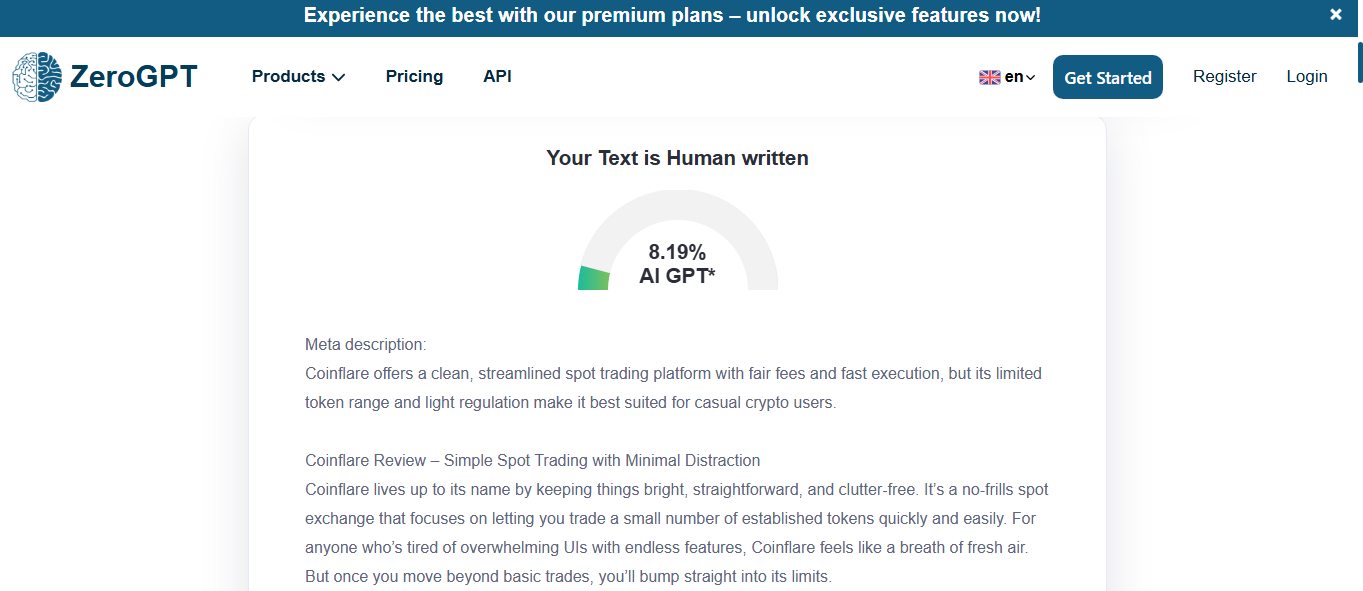Coinflare Review - Simple Spot Trading with Minimal Distraction
.png)
Coinflare lives up to its name by keeping things bright, straightforward, and clutter‑free. It’s a no‑frills spot exchange that focuses on letting you trade a small number of established tokens quickly and easily. For anyone who’s tired of overwhelming UIs with endless features, Coinflare feels like a breath of fresh air. But once you move beyond basic trades, you’ll bump straight into its limits
First Impressions and User Journey
Opening Coinflare for the first time is refreshing. You sign up with just an email or phone number, go through a simple identity check, and land on a dashboard that’s intentionally basic. It greets you with your balances, a few crypto pairs, and a straightforward trade panel. No flashing banners, no complicated sub‑menus - just a clean space designed to execute a trade and move on.
That makes it ideal for anyone who wants crypto exposure without the clutter. Touch your amount, choose market or limit, hit trade, and you’re done. It caters perfectly to first‑timers or anyone who prefers a lightweight setup.
Token Range and Market Depth
Here’s where Coinflare shows its edges - and its boundaries. You’ll typically see only major coins - Bitcoin, Ethereum, a handful of well‑known altcoins. There’s no huge alt‑coin catalog, no fresh meme projects, no obscure DeFi tokens. That tracks with the platform’s mission: easy, clean, reliable spot.
Liquidity is decent for core pairs, meaning small to medium trades fill fast with minimal slippage. If you try larger orders, though, spreads widen and execution may drag. Since Coinflare isn’t pursuing high‑frequency trading niche, its order books aren’t deep enough for sizable transactions.
Fee Structure and Funding
Trading on Coinflare won’t break the bank. Fees sit around 0.12% to 0.18%, depending on pair and occasional promos. That’s competitive for users placing routine trades. There are no complicated tiers tied to volume or coins held - everyone pays the same, which keeps things simple and predictable.
Funding works by bringing crypto in from your wallet or another exchange. There’s no fiat on‑ramp built in, so you’ll need to convert outside if you’re starting from fiat. Withdrawals are fast. Once approved, they typically arrive in your wallet within 30 to 60 minutes, depending on network traffic. A small transaction fee applies, but there are no surprise charges.
Platform Security and Oversight
Coinflare covers basic security standards - two‑factor authentication, the ability to whitelist withdrawal addresses, and a mix of hot and cold storage for user assets. There’s no news of major hacks in its history, which suggests it’s managed solidly at this scale.
But there’s a catch: Coinflare isn’t regulated by major authorities like the FCA or SEC, and there’s no formal insurance on deposited funds. Proof‑of‑reserves isn’t published either. That makes it durable for day‑to‑day use but less suitable if you want heavy institutional guarantees. Best practice: treat it as a trading platform, not a long‑term vault.
User Experience and Interface
Whether you're on desktop or mobile, Coinflare delivers a consistent experience. The site loads fast, menus are intuitive, and there's no clutter. The chart view is basic but functional, offering volume and a few adjustable indicators. The trade panel is minimalist - enter amount, choose price, click confirm, and the order is off.
That minimalism is deliberate. If you want to avoid feature overload, this is a welcome break from exchanges pushing margin, staking, DeFi integrations, and multi‑chain complexity. It comes with lean functionality, but what it does, it does well.
Ideal Users vs Those It Isn’t For
Coinflare fits comfortably if:
- You’re new to crypto and looking for an easy first platform.
- You trade only primary cryptocurrencies like BTC or ETH.
- You want a no‑nonsense interface without a learning curve.
- You move small to medium sums, not whales or big traders.
It’s less suited if:
- You trade a wide range of coins or seek niche tokens.
- You are interested in leverage, futures, or passive income through staking.
- You need industry‑standard regulatory oversight or wallet insurance.
- You require deep liquidity for large orders or institutional operations.
Coinflare makes clear sacrifices in depth to deliver clarity in design.
Risks and Caveats
Coinflare is reliable but deliberately limited. The main trade‑off: simplicity over breadth. No margin means no accidental liquidation, but also no trading flexibility. No regulated custody means you must manage risk on your own. Limited listings mean you often need other platforms to explore new coins or DeFi.
If your goal is to occasionally buy mainstream coins and hold them or trade opportunistically, Coinflare fits. If you're building a broader, more complex crypto strategy, you’ll quickly outgrow its boundaries.
Final Thoughts
Coinflare sticks faithfully to its mission: clean, fast spot trading with no extra complications. That clarity is a big strength - especially in a landscape crowded with noise. For people who want to move in, execute trades, and walk away in minutes, it’s hard to beat.
Still, understand what it’s not: it isn’t for deep liquidity seekers, leveraged traders, or users demanding heavy regulation or DeFi integrations. For those needs, Coinflare is better as a supplement than a core platform.
If all you want is a bright, focused environment to trade select coins without fuss, Coinflare delivers exactly that.

Disclaimer
“This content is for informational purposes only and does not constitute financial advice. Please do your own research before investing.”
.png)







%203.svg)
%203.svg)




















